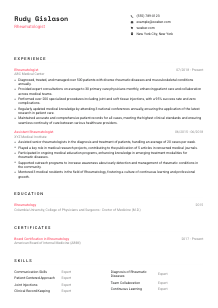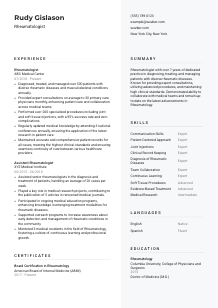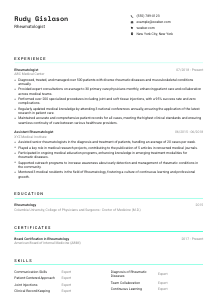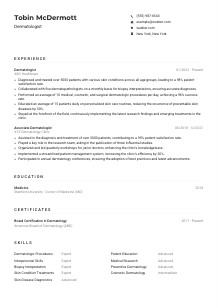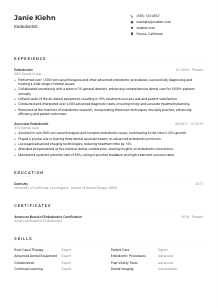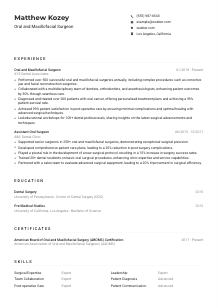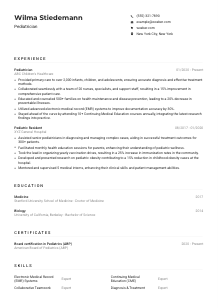Rheumatologist Resume Example
Cracking joints, but your resume feels stiff? Flex your skills with this Rheumatologist resume example, reshaped using Wozber free resume builder. See how smoothly you can align your expertise with job requisites, paving the way for your career to move as fluidly as the joints you treat!
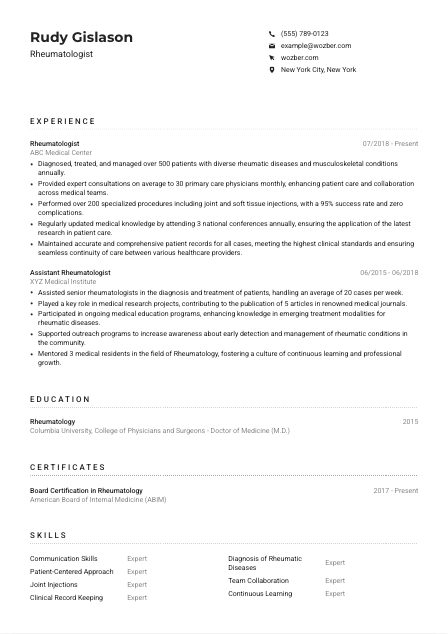
How to write a Rheumatologist Resume?
Embarking on the path to securing your dream Rheumatologist position requires more than a deep understanding of rheumatic diseases - it demands a resume that speaks volumes about your expertise, achievements, and dedication to patient care. It's not just about listing your qualifications; it's about narrating your professional journey in a way that resonates with hiring managers. Using the Wozber free resume builder, this guide is tailored specifically for you, ensuring your resume not only passes the ATS scan with flying colors using an ATS-friendly resume format but also captures the essence of your profession.
Let's sculpt your resume into a masterpiece that doors will open for!
Personal Details
Your personal introduction is the cornerstone of your resume - it's where the first impression is formed. Perfecting this section is your first step towards making a memorable impact. Here's how to tailor it perfectly for a Rheumatologist role, blending professionalism with a personalized touch.
1. Name Recognition
Your name is more than a label; it's the banner under which your achievements march. Make sure it's prominently placed and encapsulates the professional esteem you carry. A well-presented name in a clean, clear font sets the stage.
2. Professional Titling
Directly under your name, echo the title 'Rheumatologist,' showcasing your specialization from the get-go. This matching title to the job you're applying for not only aligns with the provided job description but also instantly clarifies your professional identity to the hiring manager.
3. Accurate and Accessible Contact Information
In the world of patient care and complex diagnoses, clear communication is key. Ensure your contact information is error-free. A professional email that utilizes your name underscores your professionalism, while listing your location as 'New York City, New York' addresses a specific job requirement, showing you're already in or ready to be in the heart of where the action happens.
4. Professional Online Presence
A striking addition could be your professional online profile, such as LinkedIn, which acts as an extended version of your resume. Ensure it mirrors the dedication and expertise showcased in your resume. This digital footprint can significantly elevate your first impression.
5. Privacy Matters
While it's crucial to provide necessary contact details, refrain from including personal stats that aren't needed for the job application. This preemptive step ensures your application stays focused on your professional merits.
Takeaway
The personal introduction is akin to a handshake; it needs to be firm, warm, and inviting. Strike a balance between professionalism and accessibility, making sure it memorably reflects your identity as a Rheumatologist ready to make a significant impact.





Experience
In the world of Rheumatology, experience speaks louder than words. Your work history is a testament to your commitment and expertise in the field. Let's navigate through structuring this section to highlight your profound journey.
- Diagnosed, treated, and managed over 500 patients with diverse rheumatic diseases and musculoskeletal conditions annually.
- Provided expert consultations on average to 30 primary care physicians monthly, enhancing patient care and collaboration across medical teams.
- Performed over 200 specialized procedures including joint and soft tissue injections, with a 95% success rate and zero complications.
- Regularly updated medical knowledge by attending 3 national conferences annually, ensuring the application of the latest research in patient care.
- Maintained accurate and comprehensive patient records for all cases, meeting the highest clinical standards and ensuring seamless continuity of care between various healthcare providers.
- Assisted senior rheumatologists in the diagnosis and treatment of patients, handling an average of 20 cases per week.
- Played a key role in medical research projects, contributing to the publication of 5 articles in renowned medical journals.
- Participated in ongoing medical education programs, enhancing knowledge in emerging treatment modalities for rheumatic diseases.
- Supported outreach programs to increase awareness about early detection and management of rheumatic conditions in the community.
- Mentored 3 medical residents in the field of Rheumatology, fostering a culture of continuous learning and professional growth.
1. Job Descriptions Unpacked
Begin by dissecting the rheumatologist job description offered, identifying keywords and duties such as 'diagnose, treat, and manage' and 'perform specialized procedures,' which are crucial for ATS optimization and demonstrating your suitability for the role.
2. Chronological Layout
Structuring your experience in a chronological order, starting with your most recent position, paints a clear timeline of your professional growth. This layout is not only ATS-compliant but helps the reader understand your evolving prowess in rheumatology.
3. Highlighting Achievements
Every role you list should have bullet points showcasing your accomplishments that directly reflect the job's requirements. Be it managing a high volume of patients or excelling in joint injections, these highlights should directly mirror the competencies sought by the employer.
4. The Power of Numbers
Quantifying your achievements, such as 'Diagnosed, treated, and managed over 500 patients,' or 'Provided expert consultations to 30 primary care physicians monthly,' offers concrete evidence of your impact and expertise.
5. Relevance Is Key
While it might be tempting to list all professional experiences, focus on those that directly align with the role of a Rheumatologist. This ensures every line on your resume works towards showcasing your qualifications for the position you're applying to.
Takeaway
Your experience section is where you prove you're not just a contender, but the right choice for the position. Dial into your past roles and bring forward the achievements and duties that resonate most with the Rheumatologist role. Stand tall on the foundation of your experience; let it speak to your expertise and dedication.
Education
For a Rheumatologist, your academic background is not just a requirement; it's the bedrock of your expertise. Highlighting your educational journey correctly ensures your resume resonates with both professionalism and proficiency.
1. Core Academic Requirements
Directly address the key educational requirements listed in the job description – an 'M.D. or D.O. degree from an accredited institution' alongside specialized training in 'Internal Medicine and a fellowship in Rheumatology.' These details are crucial and must be clearly stated.
2. Structured Simplicity
Keep your educational section clean and straightforward, listing your highest degree first. Mention the institution, your degree, and field of study, followed by graduation dates. This clarity aids both in ATS scanning and easy evaluation by hiring managers.
3. Tailoring Degree Titles
The exact naming of your degree matters. For instance, specifying your specialization in 'Rheumatology' and 'Internal Medicine' directly aligns with job descriptions, showcasing your targeted training and expertise, an essential step for standing out.
4. Course Highlights
Though not always necessary, listing significant coursework can be beneficial especially if these courses directly contributed to your understanding and skill set in rheumatic care. It serves as supplementary proof of your focused training.
5. Additional Academic Achievements
If you have academic honors, relevant extracurriculars, or specific projects that underscore your dedication to Rheumatology, mention them. Especially for those early in their career, these details add depth to your academic narrative.
Takeaway
Your education section is a testament to your hard work, dedication, and the rigorous journey you've embarked on to reach this point. Ensure it's crafted in a way that highlights your readiness and qualification for the Rheumatologist role. Let your educational achievements narrate your passion for the field.
Certificates
In the Rheumatology field, staying updated with the latest certifications is a hallmark of a committed professional. Displaying your certifications strategically not only vouches for your expertise but also your dedication to continuous learning.
1. Essential Certifications
"Board certification or eligibility for certification in Rheumatology by the American Board of Internal Medicine (ABIM)" should be prominently displayed. This satisfies a direct requirement from the job description, showing your qualifications are up-to-date.
2. Curated Certification List
List only the certifications that highlight your qualifications for the Rheumatologist role. This targeted approach ensures the hiring manager immediately sees your most relevant credentials, making it clear you're a strong candidate.
3. Dates and Validity
If your certifications include a period of validity or a recency that's impressive, make sure to include these dates. It underscores not just your qualifications but your initiative in keeping your knowledge and skills razor-sharp.
4. Continuous Improvement
In a field as dynamic as Rheumatology, constant upskilling is key. Highlight any recent or ongoing certification efforts, demonstrating your commitment to being at the forefront of your field, a quality any healthcare facility would value.
Takeaway
View each certification as a badge of honor, showcasing your unwavering commitment to Rheumatology. These are not just credentials; they are proof of your dedication to excellence and ongoing professional development. Let them be a proud feature of your resume, a beacon to prospective employers.
Skills
The skills section of your resume is where you get to highlight the arsenal of abilities you bring to the table. For a Rheumatologist, this means showcasing a blend of medical proficiency and soft skills that underscore your patient-centered approach.
1. Mining the Job Description
Your first step is a careful analysis of the job description. Identifying both the explicit skills like 'joint injections' and the soft skills such as 'strong interpersonal and communication skills' ensures your resume speaks directly to the employer's needs.
2. Precise Skill Matching
Tailor your skills list to include those that are most relevant to being a Rheumatologist, placing special emphasis on those mentioned in the job description. This direct mapping ensures your resume resonates perfectly with the role envisaged by the hiring team.
3. Clarity and Organization
Present your skills in a clear, organized manner, avoiding overcrowding. A meticulously crafted list that aligns with the job requirements not only aids in ATS optimization but also makes it easier for the hiring manager to recognize your suitability at a glance.
Takeaway
Your skills section is the symphony where every note is essential, echoing your professional and personal qualities. Craft it with care, ensuring each skill listed plays its part in portraying you as the consummate Rheumatologist, ready to bring your expertise and empathy to patients.
Languages
Rheumatologists often serve a diverse patient population, making linguistic skills a valuable asset. Reflecting your language proficiency can illuminate your ability to communicate effectively with patients and colleagues, enhancing patient care.
1. Language Requisites
The job description calls for a strong command of English, which should be prominently listed as your 'Native' or 'Fluent' language, emphasizing your capacity to communicate effectively in the primary language required.
2. Multilingual Advantage
Should you possess additional language skills, list them, rating your proficiency honestly. In a multicultural hub like New York City, the ability to converse in more than one language can significantly enhance patient rapport and care.
3. Honesty in Proficiency
Accurately rate your proficiency level for each language listed, ensuring expectations match reality. This transparency builds trust, an essential foundation in any patient-care profession.
4. Global Perspective
In an increasingly globalized world, multilingual skills underscore not just communication ability but a readiness to engage with diverse cultures. Highlighting these skills on your resume paints you as a well-rounded candidate, ideal for modern healthcare settings.
5. Language as a Bridge
Consider languages as bridges, forging stronger connections not just with patients but within multidisciplinary teams. Showcasing your linguistic capabilities reflects your versatility and adaptability, traits invaluable in any healthcare professional.
Takeaway
Your linguistic skills are more than a list on your resume; they're a testament to your ability to connect and communicate. In Rheumatology, where understanding and empathy are paramount, showcasing your linguistic dexterity can be a substantial advantage.
Summary
The summary section is your moment to shine, to convey in a few powerful sentences why you are the ideal candidate for the Rheumatologist position. It's about distilling your essence, your professional journey, and your aspirations into a concise narrative.
1. Job Essence
Begin your summary by internalizing the core responsibilities and requirements of the job. This deep understanding enables you to tailor your introduction in a way that resonates deeply with the hiring manager, showcasing your direct alignment with the role.
2. Personal Introduction
Open with a strong, engaging statement that highlights your profession and years of dedicated practice, just like 'Rheumatologist with over 7 years of dedicated practice.' This sets a professional yet personal tone, inviting the reader to learn more.
3. Echoing the Role
Detail the key skills and accomplishments that make you an exceptional candidate, directly mirroring the job's requirements. This creates an instant connection in the reader's mind, positioning you as the perfect match for the role.
4. Brevity is Key
Your summary should be a teaser of what's to come, providing just enough to pique interest without revealing everything. Aim for 3-5 compelling lines that invite the hiring manager to dive deeper into your resume.
Takeaway
Think of your summary as the prelude to your professional symphony. It sets the tone, establishing you as a leading candidate right from the start. With thoughtful crafting, your summary can be the compelling introduction that leads to a successful career as a Rheumatologist.
Embarking on Your Rheumatologist Journey
As you finalize your journey of crafting your Rheumatologist resume, remember, this document is more than a collection of experiences and skills; it's a reflection of your professional identity. With the guidance provided and tools like Wozber's free resume builder and ATS resume scanner at your disposal, you're well-equipped to create an ATS-compliant resume that stands out. Go forth, confident in your ability to leave a lasting impression and secure the role you've been aiming for. Your next big opportunity is just a resume away!

- Doctor of Medicine (M.D.) or Doctor of Osteopathic Medicine (D.O.) degree from an accredited institution.
- Completion of a residency program in Internal Medicine and a fellowship in Rheumatology.
- Board certification or eligibility for certification in Rheumatology by the American Board of Internal Medicine (ABIM) or the American Osteopathic Board of Internal Medicine (AOBIM).
- Minimum of 2 years of clinical experience in Rheumatology post fellowship.
- Strong interpersonal and communication skills with a patient-centered approach.
- Ability to effectively articulate in English required.
- Must be located in or willing to relocate to New York City, New York.
- Diagnose, treat, and manage patients with rheumatic diseases and musculoskeletal conditions.
- Provide expert consultations to primary care physicians and collaborate with multi-disciplinary medical teams.
- Perform specialized procedures such as joint or soft tissue injections, aspirations, and biopsies.
- Stay current with the latest research and medical developments in the field of Rheumatology.
- Maintain accurate and detailed patient records, and ensure a high standard of clinical care.





